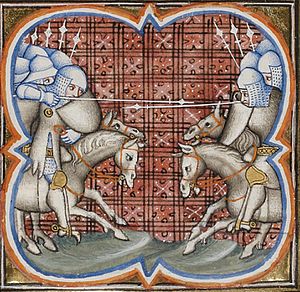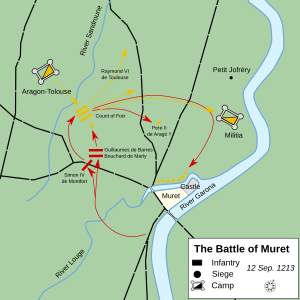Battle of Muret facts for kids
Quick facts for kids Battle of Muret |
|||||||
|---|---|---|---|---|---|---|---|
| Part of the Albigensian Crusade | |||||||
 The Battle of Muret: illustration from the Grandes Chroniques de France, c. 1375–1380 |
|||||||
|
|||||||
| Belligerents | |||||||
| Kingdom of France Northern French Crusaders |
Crown of Aragon County of Toulouse County of Comminges County of Foix Viscounty of Carcassonne |
||||||
| Commanders and leaders | |||||||
|
Peter II of Aragon † Raymond VI, Count of Toulouse Raymond-Roger, Count of Foix |
||||||
| Strength | |||||||
|
1,000–1,700 men
|
Modern estimates: No more than 10,000 fighting men 16,900–22,100 men 4,000–8,000 men
|
||||||
| Casualties and losses | |||||||
|
Light (less than 100 total casualties)
|
|
||||||
The Battle of Muret (pronounced Moo-RET) was a very important battle fought on September 12, 1213. It happened near Muret, a town about 25 kilometers (15 miles) south of Toulouse in France. This battle was the last big fight in the Albigensian Crusade.
It's famous because a smaller army of French knights and crusaders won against a much larger allied army. The French were led by Simon de Montfort the Elder. The bigger allied army was led by King Peter II of Aragon and Count Raymond VI of Toulouse.
Historians see Muret as one of the most decisive victories of the Middle Ages. It showed that Montfort was an amazing battlefield leader. He managed to defeat a king who was also a respected general.
King Peter II died in the battle. Many important people from Aragon also died. This had a lasting effect on the region. Aragon lost its power in the area called Languedoc. This allowed the Kingdom of France to take more control over these lands.
Contents
What Led to the Battle of Muret?
Simon de Montfort was the main leader of the Albigensian Crusade. This was a war to stop a religious group called the Cathars and to bring the Languedoc region under the control of the French king. Montfort took over the County of Toulouse and forced its leader, Count Raymond VI, to leave.
Count Raymond asked for help from his brother-in-law, King Peter II of Aragon. King Peter felt that Montfort's victories in Languedoc were a threat to his own lands. So, he decided to cross the Pyrenees mountains and fight Montfort at Muret.
On September 10, King Peter's army arrived at Muret. They were joined by soldiers from Languedoc. These forces were led by Count Raymond and other southern French lords. King Peter placed his army carefully. One side was protected by the Saudrune River, and the other by a marsh. He ordered the soldiers from Toulouse to attack the city walls.
Who Fought in the Battle of Muret?
Historians generally agree on the size of Simon de Montfort's army. He led about 1,000 to 1,700 French crusaders. This included around 260 knights and 500 to 700 mounted soldiers. He also had 300 to 700 foot soldiers who stayed in Muret to defend the town. So, Montfort had a total force of about 1,600 to 1,700 men.
The size of the allied army is harder to figure out. Old records often made the numbers seem much bigger than they really were. For example, one source claimed 100,000 allied soldiers, which is not possible.
Modern historians believe King Peter of Aragon brought about 800 to 1,000 Aragonese horsemen. He was joined by 2,000 to 4,000 foot soldiers from Toulouse. Other horsemen came from the areas of Comminges and Foix. In total, King Peter's combined army likely had between 4,000 and 8,000 men. This included about 2,000 to 4,000 horsemen and 2,000 to 4,000 foot soldiers. Even with these lower estimates, King Peter's army was still much larger than Montfort's.
How the Battle Unfolded
Simon de Montfort led his knights and horsemen out of the walled town of Muret. He divided his cavalry into three lines. His half-brother, William of Barres, commanded the first line. Montfort himself led the third line, so he could better control the battle. King Peter had also arranged his men in a similar way. The Count of Foix led the first line, and King Peter hid himself in a borrowed suit of armor in the second line. Once ready, King Peter's army waited for the crusaders to attack.
William of Barres' cavalry crossed a stream and charged straight into the middle of the Count of Foix's line. The second crusader line followed right behind them. The force of their charge was so strong that the allied first line was crushed. The crusaders broke through to the second line. At the same time, Montfort moved his own unit to attack the allied cavalry from their left side. This caused a lot of confusion and disorganization among the allied horsemen, and they started to retreat.
King Peter might have died right at the start of the fight. Or, the crusaders might have aimed for his flag in the second line, trying to kill him. One story says he shouted, "Here is your King!" but no one heard him. When his army learned that King Peter was dead, it caused them to panic and run away.
Montfort's first two lines chased after the fleeing allied cavalry. Montfort kept his third line in reserve, just in case the pursuers met any resistance. But this wasn't needed, as the fleeing soldiers didn't fight back.
After the cavalry was defeated, Montfort returned to Muret. The soldiers from Toulouse had been attacking the city. When they saw the crusader horsemen returning and heard that King Peter of Aragon was killed, they also broke and ran. They tried to escape towards the Garonne River but were killed as they fled.
What Happened After the Battle?
The Battle of Muret was the last major battle of the Albigensian Crusade. The crusade officially ended later, with the Treaty of Paris in 1229.
Montfort's victory and the death of King Peter meant that Aragon's plans for the Languedoc region were over. This allowed the French king to take more control over these southern lands.
See also
 In Spanish: Batalla de Muret para niños
In Spanish: Batalla de Muret para niños


